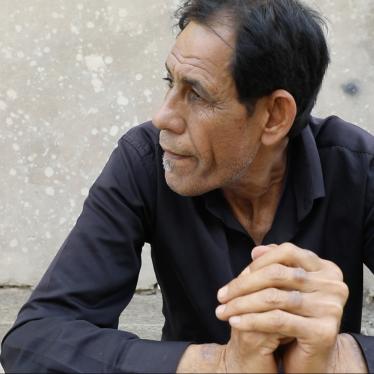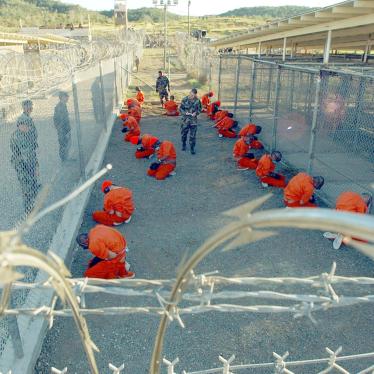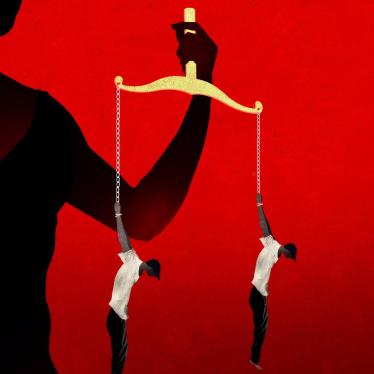"I stand for 8-10 hours a day. Why is standing limited to four hours?"
So reads a note scrawled by Defense Secretary Donald Rumsfeld on a memo released by the Pentagon this week, in which he approved for Guantanamo interrogations techniques such as forcing them to stand, stripping detainees nude and threatening them with dogs.
"I stand for 8-10 hours a day. Why is standing limited to four hours?"
So reads a note scrawled by Defense Secretary Donald Rumsfeld on a memo released by the Pentagon this week, in which he approved for Guantanamo interrogations techniques such as forcing them to stand, stripping detainees nude and threatening them with dogs.
With his characteristic cut-through-the-bull bluntness, Rumsfeld raised a valid question. If interrogators can use methods designed to inflict pain on prisoners, why should they be made to stop before the pain becomes difficult to bear? After all, forcing a prisoner to stand, so long as it's only for a short time, is a bit like allowing the use of hot irons, so long as they're only slightly above room temperature. The contradiction Rumsfeld noticed may help us understand how decisions made by senior officials and military commanders led to the abuse of prisoners in Abu Ghraib.
The policymakers apparently tried to have it both ways, approving highly coercive interrogation techniques, but with limits designed to assuage their consciences and satisfy their lawyers. They authorized or proposed painful "stress positions," but said that no one position could be used for more than 45 minutes. They allowed forced standing, but only for four hours; sleep deprivation, but only for 72 hours; exposure to heat and cold, but with medical monitoring; hooding, but not in a way that limits breathing; and nudity, but not the stacking of nude bodies.
Once these methods were applied in the field on prisoners considered to be hardened terrorists, however, interrogators did not respect the lawyers' boundaries. Indeed, they could not have respected them while still achieving their aim of forcing information from detainees. For by definition, these methods, euphemistically known as "stress and duress," can work only when applied beyond the limits of a prisoner's tolerance. Torture works only (if ever) when it truly feels like torture.
Perhaps one reason these stress and duress techniques were approved at all is that they sound innocuous. But as anyone who has worked with torture victims knows, they are the stock in trade of brutal regimes around the world. For example, the Washington Times recently reported that "[s]ome of the most feared forms of torture cited" by survivors of the North Korean gulag "were surprisingly mundane: Guards would force inmates to stand perfectly still for hours at a time, or make them perform exhausting repetitive exercises such as standing up and sitting down until they collapsed from fatigue."
Binding prisoners in painful positions is a torture technique widely used in countries such as China and Burma, and repeatedly condemned by the United States. Stripping Muslim prisoners nude to humiliate them was a common practice of the Soviet military when it occupied Afghanistan. As for sleep deprivation, consider former Israeli Prime Minister Menachem Begin's account of experiencing it in a Soviet prison in the 1940s:
"In the head of the interrogated prisoner a haze begins to form. His spirit is wearied to death, his legs are unsteady, and he has one sole desire: to sleep, to sleep just a little, not to get up, to lie, to rest, to forget. . . . Anyone who has experienced this desire knows that not even hunger or thirst are comparable with it. . . . I came across prisoners who signed what they were ordered to sign, only to get what the interrogator promised them. He did not promise them their liberty. He promised them -- if they signed -- uninterrupted sleep!"
Rumsfeld eventually rescinded his approval of these cruel methods for Guantanamo. But they still ended up being authorized by commanders and used on prisoners throughout Afghanistan and Iraq. Former detainees report being forced to stand, sit or crouch for many hours, often in contorted positions, deprived of sleep for nights on end, held nude, doused with cold water and exposed to extreme heat.
It's not likely anyone was holding a stopwatch during this treatment or making sure that only "mild" pain and suffering resulted. Why would they have? For the limits that might have made the treatment more humane would also have rendered it ineffective in the eyes of interrogators.
Stress and duress interrogation techniques were invented in the dungeons of the world's most brutal regimes for only one purpose -- to cause pain, distress and humiliation, without physical scars. When Bush administration officials and military commanders told soldiers to use methods designed for that purpose, while still treating detainees "humanely," they were being naive at best and dishonest at worst. They should have known that once the purpose of inflicting pain is legitimized, those charged with the care and interrogation of prisoners will take it to its logical conclusion.








